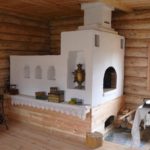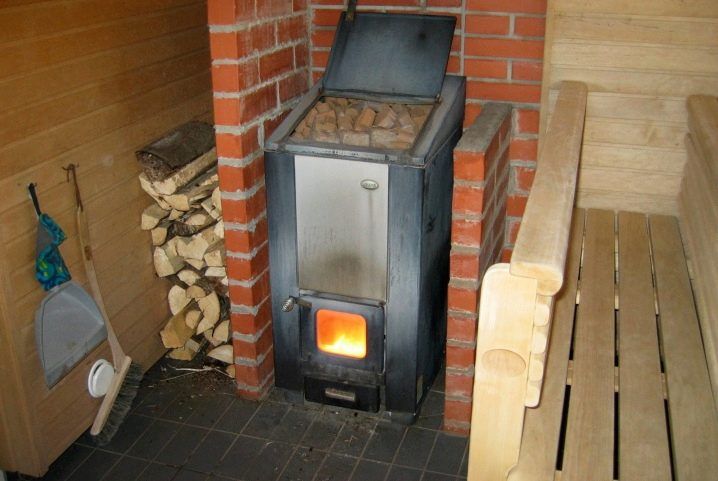How to wash in a Russian oven
The life of our ancestors was ideally adapted to the conditions in which they lived. The Russian stove rightfully occupied a key place. Which is no wonder - the harsh climate with long and frosty winters put fuel reserves on par with food supplies. And firewood, just like bread, was oh so difficult to come by.
The content of the article
Where did the custom of washing in the oven come from?
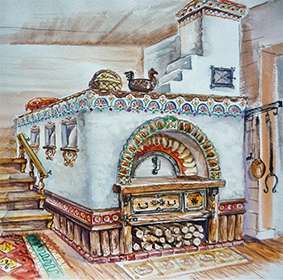 Just imagine, a tree (usually birch, it has excellent heat capacity, almost twice as much as spruce, second only to oak among local species) grows at least a kilometer away, or even two or three. This is because everything around the Russian village has been uprooted and plowed up. You have to get there, of course, not on foot, but by cart. The tree needs to be felled. Nowadays this is an easy task with a chainsaw, but previously it took a lot of swinging with an axe. Then the felled tree had to be divided into pieces in order to be loaded. Then the logs delivered to the house were cut into logs, which should be split and carefully folded, if possible covering the top from the rain. It took two strong workers a whole day to make one cart.
Just imagine, a tree (usually birch, it has excellent heat capacity, almost twice as much as spruce, second only to oak among local species) grows at least a kilometer away, or even two or three. This is because everything around the Russian village has been uprooted and plowed up. You have to get there, of course, not on foot, but by cart. The tree needs to be felled. Nowadays this is an easy task with a chainsaw, but previously it took a lot of swinging with an axe. Then the felled tree had to be divided into pieces in order to be loaded. Then the logs delivered to the house were cut into logs, which should be split and carefully folded, if possible covering the top from the rain. It took two strong workers a whole day to make one cart.
For the winter, the average peasant family needed at least 10–15 cartloads of firewood. And if at the same time you heat the famous Russian bathhouse, then all 25.
IMPORTANT! The custom helped to significantly save resources and thus had a significant influence on many aspects of life in the village in the old days.
Who washed in the oven?
It is clear that the bathhouse was a luxury that only very strong households could afford. As for the rest, they were once again rescued by the miracle stove, which did not require any additional firewood to wash the whole family. Simply using the heat that was left over from cooking. Due to its rationality, this custom was widespread throughout the territory of Rus', of which there is a lot of evidence.
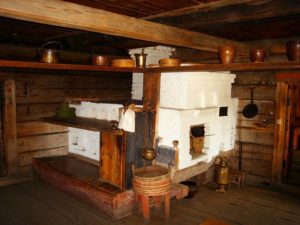
How they used to wash in a Russian oven
It all started at the construction stage. The oven was built in such a way that it could easily accommodate an adult person and one or two gangs of water. There should still be room left to wave a broom. Therefore, the heart of the Russian hut was so large that sometimes it could occupy almost a third of the entire room. To imagine what such a stove looked like, you can look at the photo. But this made it possible to sleep on top of it, in warmth, when the whole hut was slowly cooling down. In the cold season, large size was a significant advantage.
The stove was heated, of course, in the morning. The hostess got up before everyone else, lit a fire and prepared food. They heated cast iron with water. When the coals burned out, the remaining ash was swept out. The oven, which had already cooled down, was washed. Moreover, there was no need to wash the vault; due to the high temperature, when the wood was burning, all the soot fell off on its own, practically without a trace. The so-called under was lined with straw for greater comfort. Water and pre-prepared decoctions of medicinal herbs were poured into the gangs, which were always wooden so as not to get burned.
REFERENCE. Some herbs that were used in Rus' to prepare bath infusions.
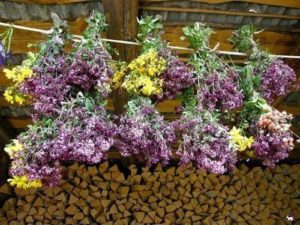 Sagebrush. The dried and crushed plant was rubbed on the skin. This was done to heal wounds, bruises and ulcers.In addition, the procedure relieved headaches, nervous tension and increased performance.
Sagebrush. The dried and crushed plant was rubbed on the skin. This was done to heal wounds, bruises and ulcers.In addition, the procedure relieved headaches, nervous tension and increased performance.- St. John's wort. Also used in dried and crushed form. The powder was sprinkled on the body to get rid of skin diseases and gout.
- Field mint. It was used more to lift the mood, as it has a very pleasant smell. But there is also evidence that it has a positive effect on the body during colds.
- Chamomile. The plant, widely known for its medicinal properties, contains large amounts of vitamins and essential oils. Has a positive effect on skin health.
- Linden blossom. When steamed, it emits a very pleasant smell that calms the nervous system and promotes sound, refreshing sleep.
- Horseradish. In any form, it fights colds perfectly. Strengthens the immune system.
- Black currant leaves act similarly.
- Pine and spruce needles, brewed in boiling water, infused, splashed onto stones and turned into steam, can have a positive complex effect on the body.
- Green hop cones can cause a surge of energy. They should be used if you still have a lot to do after the bath.
Those who liked it hot washed first. It is clear that in terms of temperature, the Russian stove could give a head start to any steam room. Therefore, caution had to be exercised. Well, as it cools down, so do the rest. The little ones were washed at the end, when the heat subsided, by placing them on a wooden shovel and bringing them inside to their mother, who was waiting there. If the heat began to not be enough, the mouth of the furnace was closed from the outside with a damper. In this case, all procedures had to be done by touch. Which, of course, required some skill. If it was necessary to wash a sick or infirm person, then he was served inside in the same way as a child, only not on a shovel, but placed on a wide board.It had to be fake. Because the scent from linden is pleasant and there is no resin like from spruce or pine.
Instead of modern shampoos and gels, they used ash or a chicken egg. And often they didn’t use anything at all. Hot water, and even with a perfumed infusion of all kinds of herbs, washed everything perfectly, without drying out the skin, but leaving it soft and silky.
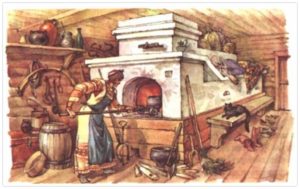 Another interesting custom is associated with washing in a Russian oven. The fact is that only married women could go to the bathhouse. The ancestors sincerely believed in the “bannik” - a kind of brownie, which red girls and widows should have been seriously wary of. There may also be some rationale here. Before the wedding, the girl had to be raised in purity and purity, and the bathhouse is usually located in the distance, and in solitude, you never know. It’s better to steam in the oven, everything will be calmer.
Another interesting custom is associated with washing in a Russian oven. The fact is that only married women could go to the bathhouse. The ancestors sincerely believed in the “bannik” - a kind of brownie, which red girls and widows should have been seriously wary of. There may also be some rationale here. Before the wedding, the girl had to be raised in purity and purity, and the bathhouse is usually located in the distance, and in solitude, you never know. It’s better to steam in the oven, everything will be calmer.
It is curious that the water that the steamers poured on themselves, quite abundantly, was disposed of practically without external intervention. Most of it, passing through the straw and bricks and a layer of sand laid closely without mortar, simply flowed into the underground or directly onto the earthen floor.
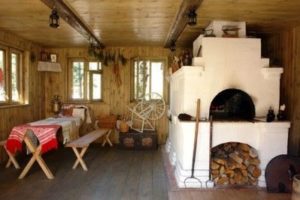 In addition to cleaning, the stove also protected health. Imagine the situation. November. Rain. Wind. It's very chilly outside. In the evening, a tired, wet and chilled worker stumbles into the hut. Trouble! It's going to be hot tomorrow! But an experienced housewife forces him to take off all his wet clothes and warm up in the stove, which was still heated in the morning, without wasting a minute. And only then, steamed and red, changed into dry and clean clothes, he sits him down at the table. The next morning the person is cheerful and cheerful, there is no talk of any cold.
In addition to cleaning, the stove also protected health. Imagine the situation. November. Rain. Wind. It's very chilly outside. In the evening, a tired, wet and chilled worker stumbles into the hut. Trouble! It's going to be hot tomorrow! But an experienced housewife forces him to take off all his wet clothes and warm up in the stove, which was still heated in the morning, without wasting a minute. And only then, steamed and red, changed into dry and clean clothes, he sits him down at the table. The next morning the person is cheerful and cheerful, there is no talk of any cold.
This is such a miracle RUSSIAN stove, created by the collective genius of our ancestors, and which is still used in some places to this day.



